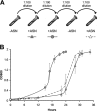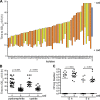Conditioning of uropathogenic Escherichia coli for enhanced colonization of host
- PMID: 19255192
- PMCID: PMC2681758
- DOI: 10.1128/IAI.01200-08
Conditioning of uropathogenic Escherichia coli for enhanced colonization of host
Abstract
While in transit within and between hosts, uropathogenic Escherichia coli (UPEC) encounters multiple stresses, including substantial levels of nitric oxide and reactive nitrogen intermediates. Here we show that UPEC, the primary cause of urinary tract infections, can be conditioned to grow at higher rates in the presence of acidified sodium nitrite (ASN), a model system used to generate nitrosative stress. When inoculated into the bladder of a mouse, ASN-conditioned UPEC bacteria are far more likely to establish an infection than nonconditioned bacteria. Microarray analysis of ASN-conditioned bacteria suggests that several NsrR-regulated genes and other stress- and polyamine-responsive factors may be partially responsible for this effect. Compared to K-12 reference strains, most UPEC isolates have increased resistance to ASN, and this resistance can be substantially enhanced by addition of the polyamine cadaverine. Nitrosative stress, as generated by ASN, can stimulate cadaverine synthesis by UPEC, and growth of UPEC in cadaverine-supplemented broth in the absence of ASN can also promote UPEC colonization of the bladder. These results suggest that UPEC interactions with polyamines or stresses such as reactive nitrogen intermediates can in effect reprogram the bacteria, enabling them to better colonize the host.
Figures




References
-
- Archer, D. L. 1996. Preservation microbiology and safety: evidence that stress enhances virulence and triggers adaptive mutations. Trends Food Sci. Technol. 791-95.
-
- Benjamin, N., and R. Dykhuizen. 1999. Nitric oxide and epitheilial host defense, p. 215-230. In F. C. Fang (ed.), Nitric oxide and infection. Kluwer Academic/Plenum Publishers, New York, NY.
-
- Blattner, F. R., G. Plunkett III, C. A. Bloch, N. T. Perna, V. Burland, M. Riley, J. Collado-Vides, J. D. Glasner, C. K. Rode, G. F. Mayhew, J. Gregor, N. W. Davis, H. A. Kirkpatrick, M. A. Goeden, D. J. Rose, B. Mau, and Y. Shao. 1997. The complete genome sequence of Escherichia coli K-12. Science 2771453-1474. - PubMed
Publication types
MeSH terms
Substances
Associated data
- Actions
Grants and funding
LinkOut - more resources
Full Text Sources
Medical
Molecular Biology Databases

